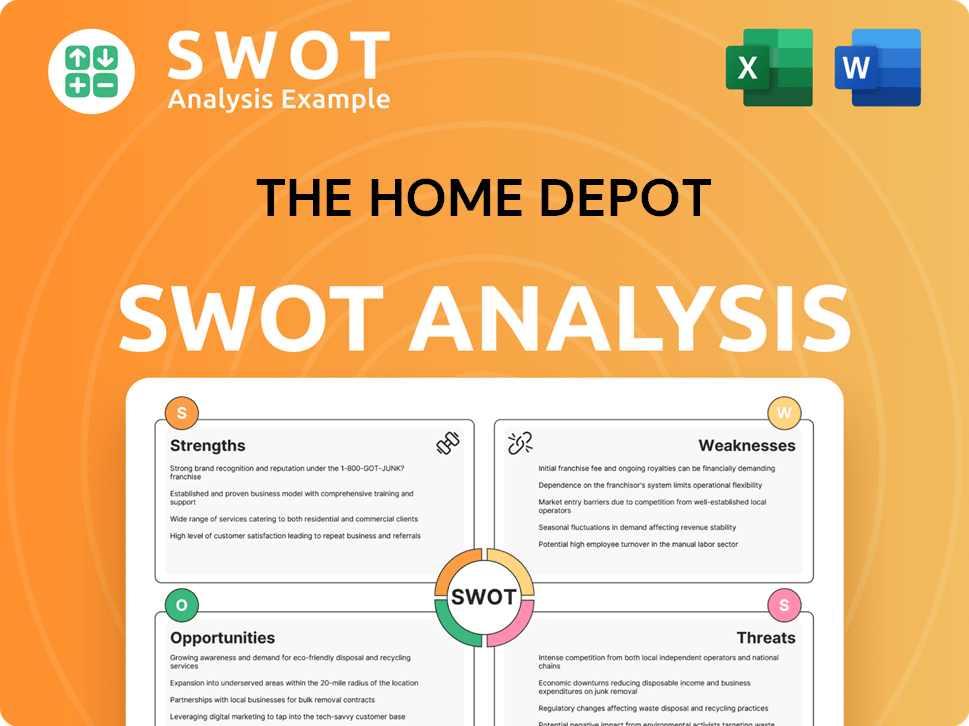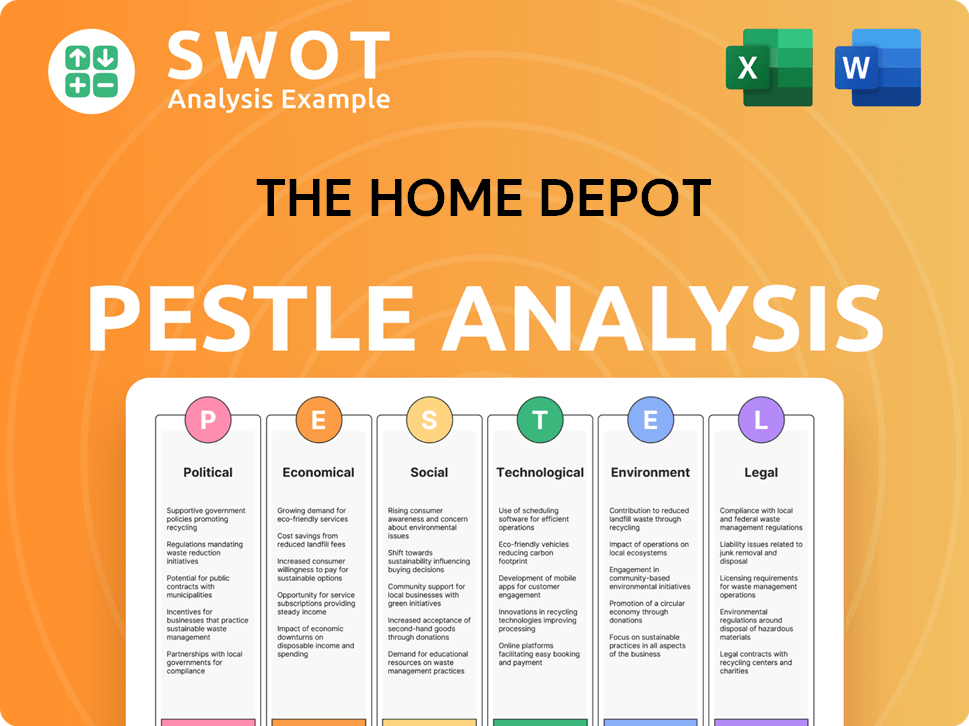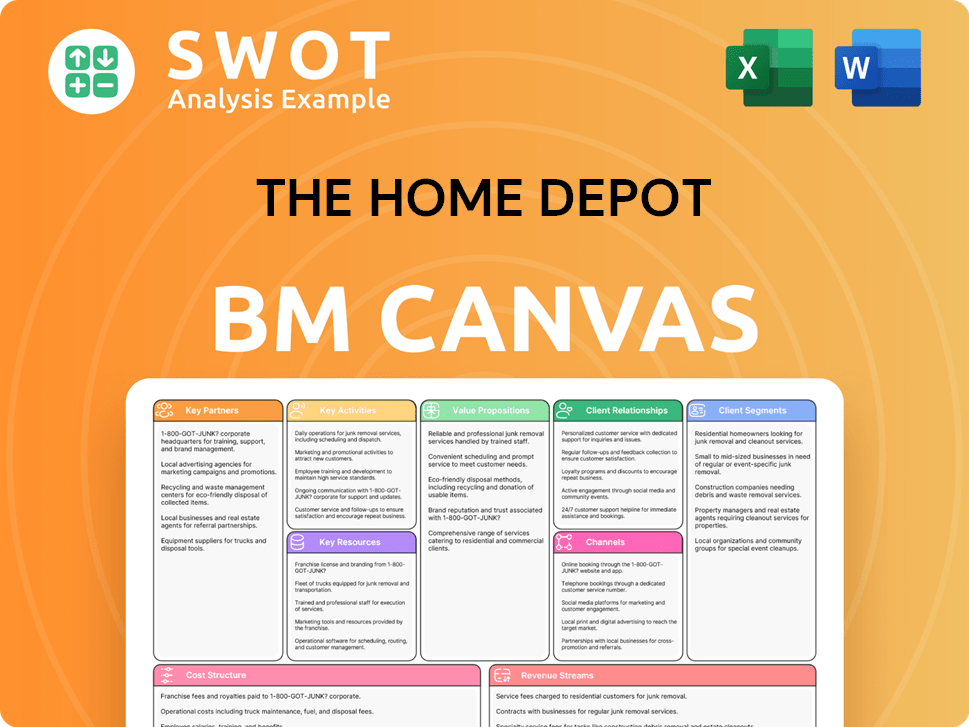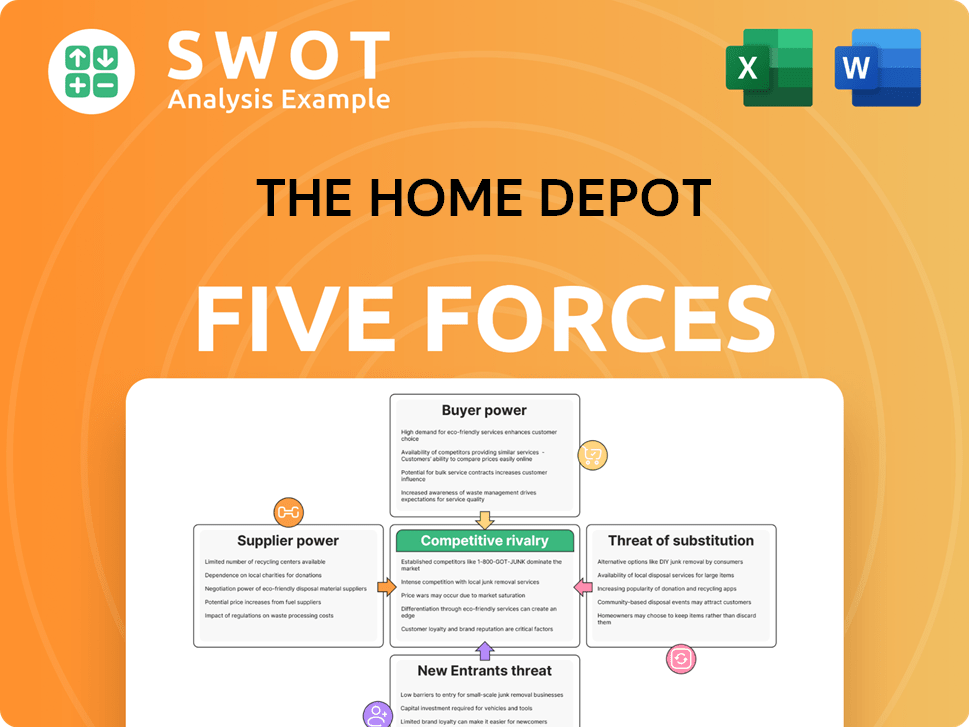The Home Depot Bundle
How Does Home Depot Thrive in the Retail World?
Home Depot, a titan in the home improvement sector, isn't just a store; it's a cornerstone of the industry. With a staggering $152.7 billion in net sales in fiscal year 2023, this retail company continues to demonstrate its remarkable influence and market dominance. From DIY projects to professional contractor needs, Home Depot caters to a vast customer base with an expansive product selection.

Understanding the inner workings of Home Depot, the world's largest home improvement retailer, is essential for anyone interested in the retail landscape. This deep dive will explore how Home Depot operates, generates revenue, and maintains its competitive edge. For a deeper look at its strategic positioning, consider exploring The Home Depot SWOT Analysis to gain a comprehensive understanding of its strengths, weaknesses, opportunities, and threats.
What Are the Key Operations Driving The Home Depot’s Success?
The core operations of the Home Depot revolve around providing a comprehensive selection of home improvement products and services. This caters to both do-it-yourself (DIY) enthusiasts and professional contractors (Pro customers). Its value proposition lies in offering a wide array of items, from building materials and tools to appliances and garden supplies, making it a one-stop shop for home improvement needs.
The company's operational model is meticulously structured, starting with a global sourcing network that procures products from thousands of vendors. A sophisticated supply chain and distribution network ensures efficient delivery to its extensive network of stores and directly to customers. This integrated approach, combined with a focus on customer service, differentiates Home Depot in the market.
The company's success is deeply rooted in its ability to provide value to a broad customer base. This includes offering convenience, competitive pricing, and a vast selection of products. The company also provides a range of services such as home installation services for products like carpeting, cabinets, and water heaters, as well as tool and equipment rental.
The company offers a vast array of products, including building materials, lumber, tools, paint, hardware, plumbing, electrical, flooring, garden supplies, and appliances. This comprehensive selection caters to diverse home improvement needs. The wide range ensures customers can find everything they need for their projects in one place.
Beyond products, the company provides various services. These include home installation services for products like carpeting, cabinets, and water heaters. They also offer tool and equipment rental. These services enhance customer convenience and support DIY projects.
The company caters to two primary customer segments: DIY customers and professional contractors (Pro customers). Tailored services and product assortments are offered for each segment. For instance, the company offers Pro Xtra loyalty programs and dedicated Pro Desks in stores to better serve contractors.
Sales channels include physical stores designed for easy navigation and product accessibility. A rapidly expanding interconnected retail platform integrates online and in-store experiences. This omnichannel approach enhances customer convenience and accessibility.
The company's operational efficiency is a cornerstone of its success. This includes a robust supply chain, efficient distribution, and a focus on customer service. The company's ability to manage these aspects effectively contributes to its competitive advantage. For more detailed information on the company's financial performance, consider reading about Owners & Shareholders of The Home Depot.
- Supply Chain: The company operates a sophisticated supply chain and distribution network. This involves strategically located distribution centers and a large fleet of trucks.
- Customer Service: Knowledgeable associates are available to assist customers in stores and through various digital channels. This enhances the overall customer experience.
- Pro Customer Focus: The company offers tailored services and product assortments for professional contractors. This includes Pro Xtra loyalty programs and dedicated Pro Desks.
- Financial Performance: In fiscal year 2023, the company's net sales were approximately $152.7 billion. The company's focus on operational excellence has consistently delivered strong financial results.
The Home Depot SWOT Analysis
- Complete SWOT Breakdown
- Fully Customizable
- Editable in Excel & Word
- Professional Formatting
- Investor-Ready Format

How Does The Home Depot Make Money?
The primary revenue streams for the company, a leading retail company in the home improvement sector, are centered around product sales and service offerings. The company leverages its extensive network of stores and online platforms to generate substantial revenue from a wide array of home improvement products.
The company's strategy focuses on providing a comprehensive shopping experience, which includes both product sales and value-added services. These services are designed to enhance customer satisfaction and drive additional revenue. This approach allows the company to maintain a strong market position.
The company's revenue model is primarily based on the sale of merchandise. This includes a vast selection of building materials, home improvement products, and decor items. For fiscal year 2023, the company reported net sales of $152.7 billion, demonstrating its significant market presence. The diverse product categories contribute to a stable revenue base, reducing reliance on any single product line.
Beyond product sales, the company generates revenue through various services, including installation, tool rental, and its interconnected retail platform. These services enhance the customer experience and provide additional revenue streams. The company continually evaluates and expands its service offerings to meet evolving customer needs and market opportunities.
- Installation Services: The company offers home improvement installation services, coordinating projects like flooring and window installations through third-party contractors.
- Tool and Equipment Rental: Customers can rent specialized tools for DIY projects, providing access to equipment without the need for purchase.
- Interconnected Retail Platform: The company's platform enhances both online and in-store sales, offering services like Buy Online, Pick Up In Store (BOPIS) and curbside pickup.
- Pro Xtra Loyalty Program: This program encourages repeat business from professional customers by offering exclusive benefits and pricing.
The Home Depot PESTLE Analysis
- Covers All 6 PESTLE Categories
- No Research Needed – Save Hours of Work
- Built by Experts, Trusted by Consultants
- Instant Download, Ready to Use
- 100% Editable, Fully Customizable

Which Strategic Decisions Have Shaped The Home Depot’s Business Model?
The journey of The Home Depot, a leading retail company, has been marked by significant milestones and strategic initiatives. These have been instrumental in shaping its current operational and financial standing. A key strategic move has been the continuous investment in its interconnected retail strategy, enhancing e-commerce capabilities and integrating online and in-store shopping experiences. This adaptation has been crucial in response to evolving consumer behaviors, especially after the pandemic.
The company has consistently focused on strengthening its Pro business, recognizing the significant revenue potential from professional contractors. This includes tailored product assortments, dedicated Pro Desks, and specialized services. Operational challenges, such as global supply chain disruptions, have been addressed with strategic investments in supply chain resilience and technology to optimize inventory management and product flow.
Home Depot's competitive advantages are multifaceted, including immense brand strength, customer loyalty, economies of scale, and a vast network of physical stores. The company continues to adapt to new trends, such as the increasing demand for sustainable products and smart home technology, by expanding its product offerings and ensuring its supply chain can support these evolving needs. For example, in fiscal year 2023, Home Depot's net sales were approximately $152.7 billion, demonstrating its strong market position.
Home Depot's history includes rapid expansion and strategic acquisitions. The company has consistently focused on enhancing the customer experience and expanding its product offerings. The company has adapted to changing market dynamics by investing in technology and supply chain improvements.
A major strategic move has been the investment in its interconnected retail strategy, integrating online and in-store experiences. Strengthening the Pro business with tailored services and product assortments is another key focus. Home Depot has also invested in supply chain resilience to improve efficiency.
Home Depot benefits from strong brand recognition and customer loyalty. Economies of scale provide a cost advantage in purchasing and distribution. The company's extensive store network and robust digital platform create a powerful ecosystem, sustaining its business model.
The company is expanding its product offerings to include sustainable products and smart home technology. Home Depot is ensuring its supply chain can support these evolving needs. This demonstrates its commitment to meeting changing customer demands.
Home Depot's strategic focus includes enhancing its online presence and catering to professional contractors. The company's strong financial performance and market position are supported by its ability to adapt to changing consumer behaviors and market trends. The company's success is reflected in its financial results and its ability to maintain a leading position in the home improvement retail sector. Learn more about the Growth Strategy of The Home Depot.
- Investments in e-commerce and supply chain.
- Expansion of product offerings to meet evolving consumer needs.
- Focus on customer service and satisfaction.
- Strong financial performance and market leadership.
The Home Depot Business Model Canvas
- Complete 9-Block Business Model Canvas
- Effortlessly Communicate Your Business Strategy
- Investor-Ready BMC Format
- 100% Editable and Customizable
- Clear and Structured Layout

How Is The Home Depot Positioning Itself for Continued Success?
The Home Depot holds a significant position in the home improvement retail sector. As the world's largest home improvement retailer, it has a substantial market share and a broad global reach. Its widespread network of stores across North America, combined with a robust online presence, fosters customer loyalty and repeat business. This dual approach caters to both DIY enthusiasts and professional contractors, broadening its customer base and revenue streams.
However, the company faces several risks, including fluctuations in the housing market and economic downturns, which can impact consumer spending. Competition from other large retailers, specialty stores, and online retailers demands continuous innovation and competitive pricing. Supply chain disruptions also pose ongoing challenges. The future outlook involves strategic initiatives to sustain and expand revenue generation.
The Home Depot is the leading player in the home improvement market. Its vast store network and online platform create a strong retail presence. The company's ability to serve both DIY customers and professional contractors supports its market leadership. The company's success is evident in its financial performance and market share.
Fluctuations in the housing market and economic downturns pose risks. Intense competition from other retailers and online platforms requires constant innovation. Supply chain disruptions can affect product availability and costs. These risks can impact profitability and market share.
The company focuses on strategic initiatives to sustain and expand revenue. Investment in its interconnected retail experience and enhancing its Pro business are key. Optimizing the supply chain is a priority for greater efficiency. The company aims to solidify its market leadership.
In the fiscal year 2023, The Home Depot reported net sales of approximately $152.7 billion. The company's focus on the professional contractor segment has been a key driver of growth. The company has also been investing in its online platform and supply chain to improve customer experience and operational efficiency.
The Home Depot is focused on several strategic initiatives to drive growth and maintain its market position. These include enhancing its interconnected retail experience, further developing its Pro business, and optimizing its supply chain. The company is also leveraging technology to personalize customer experiences and improve operational efficiencies. The company's strategic approach is detailed in this article about the Marketing Strategy of The Home Depot.
- Investment in the interconnected retail experience, blending online and in-store shopping.
- Expansion of the Pro business to cater to professional contractors.
- Optimization of the supply chain to improve efficiency and resilience.
- Use of technology to enhance customer experiences and streamline operations.
The Home Depot Porter's Five Forces Analysis
- Covers All 5 Competitive Forces in Detail
- Structured for Consultants, Students, and Founders
- 100% Editable in Microsoft Word & Excel
- Instant Digital Download – Use Immediately
- Compatible with Mac & PC – Fully Unlocked

Related Blogs
- What are Mission Vision & Core Values of The Home Depot Company?
- What is Competitive Landscape of The Home Depot Company?
- What is Growth Strategy and Future Prospects of The Home Depot Company?
- What is Sales and Marketing Strategy of The Home Depot Company?
- What is Brief History of The Home Depot Company?
- Who Owns The Home Depot Company?
- What is Customer Demographics and Target Market of The Home Depot Company?
Disclaimer
All information, articles, and product details provided on this website are for general informational and educational purposes only. We do not claim any ownership over, nor do we intend to infringe upon, any trademarks, copyrights, logos, brand names, or other intellectual property mentioned or depicted on this site. Such intellectual property remains the property of its respective owners, and any references here are made solely for identification or informational purposes, without implying any affiliation, endorsement, or partnership.
We make no representations or warranties, express or implied, regarding the accuracy, completeness, or suitability of any content or products presented. Nothing on this website should be construed as legal, tax, investment, financial, medical, or other professional advice. In addition, no part of this site—including articles or product references—constitutes a solicitation, recommendation, endorsement, advertisement, or offer to buy or sell any securities, franchises, or other financial instruments, particularly in jurisdictions where such activity would be unlawful.
All content is of a general nature and may not address the specific circumstances of any individual or entity. It is not a substitute for professional advice or services. Any actions you take based on the information provided here are strictly at your own risk. You accept full responsibility for any decisions or outcomes arising from your use of this website and agree to release us from any liability in connection with your use of, or reliance upon, the content or products found herein.